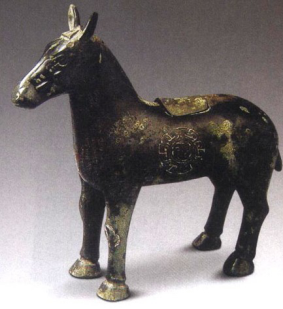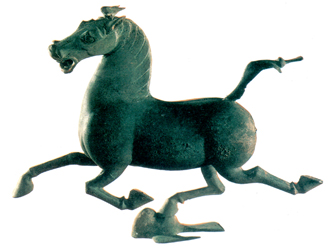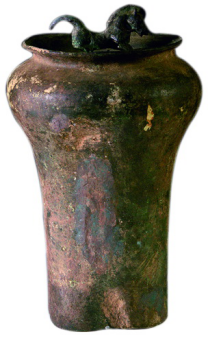Bronze Gui with Horse Design

Western Zhou (1046—71BC)
Height: 30.6cm; Base Length: 20cm
Excavated from Jinquan Village, Lianhe Chong, Taojiang County
Gui is a kind of food container used in sacrificial ceremony.
This Bronze Gui comprises a bulged belly, a thin waist under the belly and a square base at the bottom. Four horses, with horse bodies in plain and high relief and horse heads in three-dimensional relief, are decorated at the shoulder. The Loong (a magical animal in Chinese myth) patterns with two bodies are decorated between the above small horses. The horse heads had been lost when it was excavated and the forward-looking posture what we see now is the reconstruction according to the remaining parts such as the horse bodies and necks.
The belly is decorated with two groups of animal face patterns and four phoenixes. Two handles must have been arranged on the two sides, which had been lost. At the base, horse heads stretch out from four corners. Two longer sides of the square are decorated with the horse body relief and the other two shorter sides with animal face patterns. What deserves our attentions in the casting aspects is that the patterns on the bronze surface are protruding and the inner surface thereby concave, giving rise to the basically even thickness of the bronze body.
深入探索
The Horse in Chinese Culture
Horses are liked and admired by countless people all over the world because horses are strong, graceful, elegant, yet extremely powerful creatures.
Horses were the most effective and swiftest tools in war, facilitating transportation and communications in ancient China. The strong cavalry was also very important in resisting the invasion by the Huns and keeping peace in the northern frontier of the Han Dynasty (202BC-220 AD). Thus, people had the strongest reverence for horses at that time and regarded them as symbols of sanctity, power and the outstanding achievements of the nation.
Due to their natural companionship with man in both art and work, the Horse occupies an important place in history, ranking marks of honor, symbolism and reverence. As a result, many images of steeds can be found in Han sculptures and craftworks.

Horse Zun
Western Zhou Dynasty (ca 11th century—770BC)
From the collection of National Museum of China

Bronze Galloping Horse Treading on a Flying Swallow
Eastern Han Dynasty (25—220AD)
From the collection of Gansu Provincial Museum

Bronze Chunyu (Musical Instrument) with Horse-shaped Handle
From the collection of Hunan Provincial Museum



